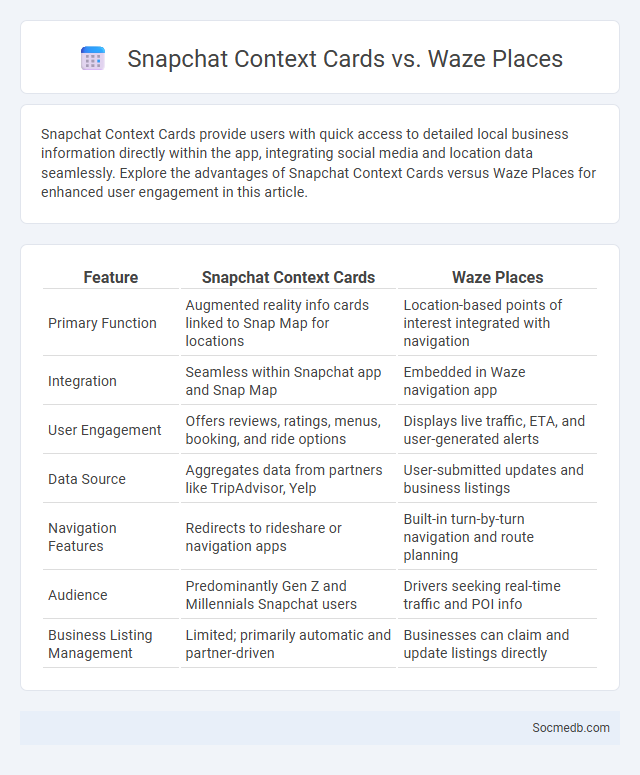
Photo illustration: Snapchat Context Cards vs Waze Places
Snapchat Context Cards provide users with quick access to detailed local business information directly within the app, integrating social media and location data seamlessly. Explore the advantages of Snapchat Context Cards versus Waze Places for enhanced user engagement in this article.
Table of Comparison
| Feature | Snapchat Context Cards | Waze Places |
|---|---|---|
| Primary Function | Augmented reality info cards linked to Snap Map for locations | Location-based points of interest integrated with navigation |
| Integration | Seamless within Snapchat app and Snap Map | Embedded in Waze navigation app |
| User Engagement | Offers reviews, ratings, menus, booking, and ride options | Displays live traffic, ETA, and user-generated alerts |
| Data Source | Aggregates data from partners like TripAdvisor, Yelp | User-submitted updates and business listings |
| Navigation Features | Redirects to rideshare or navigation apps | Built-in turn-by-turn navigation and route planning |
| Audience | Predominantly Gen Z and Millennials Snapchat users | Drivers seeking real-time traffic and POI info |
| Business Listing Management | Limited; primarily automatic and partner-driven | Businesses can claim and update listings directly |
Introduction to Location-Based Context Features
Location-based context features in social media leverage GPS, Wi-Fi, and cellular data to provide personalized content and enhance user engagement. These features enable real-time geotagging, localized recommendations, and location-specific advertising by analyzing user movements and nearby points of interest. Integrating spatial data improves relevance in social feeds, boosts targeted marketing effectiveness, and facilitates community building centered around geographic proximity.
What Are Snapchat Context Cards?
Snapchat Context Cards provide users with detailed information about locations, businesses, and events featured in Snaps, enhancing the interactive experience. These cards integrate third-party services like TripAdvisor, Foursquare, and OpenTable to offer reviews, directions, hours of operation, and booking options directly within the app. By leveraging location data and user content, Snapchat Context Cards deliver relevant and actionable insights that improve local discovery and engagement.
Understanding Waze Places
Waze Places offers a powerful platform for businesses to enhance visibility and attract drivers by listing accurate location details, hours, and contact information. You can leverage user-generated real-time traffic updates and reviews to optimize your presence and improve customer engagement. Accurate and up-to-date Waze Places data boosts your local SEO and drives targeted traffic directly to your business location.
Overview of Generic Context Cards
Generic Context Cards on social media platforms provide essential information about posts, accounts, or links to enhance user understanding and combat misinformation. These cards often display source credibility, related facts, and content context, helping You make informed decisions while browsing. By integrating these cards, platforms promote transparency and user trust across diverse content types.
Key Features Comparison: Snapchat vs. Waze vs. Context Cards
Snapchat offers ephemeral multimedia messaging and interactive AR filters, enhancing personal communication and entertainment. Waze excels in real-time community-driven navigation with live traffic updates and route optimization, ensuring you reach your destination efficiently. Context Cards provide detailed local business information and reviews directly from maps, enriching your exploration with relevant, location-specific insights.
User Interface and Experience Differences
Social media platforms vary significantly in User Interface (UI) and User Experience (UX) designs, impacting how you interact with content and navigate features. Platforms like Instagram prioritize visual content with intuitive swipe gestures, while Twitter emphasizes real-time text updates and streamlined timelines for quick information access. Understanding these differences can help you choose the platform that best suits your engagement style and preferences.
Data Integration and Source Reliability
Data integration in social media platforms ensures seamless aggregation of user information from multiple sources, enhancing the accuracy and personalization of your online experience. Reliable source verification mechanisms filter out misinformation, improving trustworthiness across shared content. Leveraging advanced algorithms, social media networks prioritize data integrity to maintain platform credibility and user engagement.
Real-Time Updates and Accuracy
Social media platforms prioritize real-time updates to deliver the latest news and events instantly to users, enhancing engagement and information flow. Advanced algorithms and user-generated content contribute to the accuracy of information, though verification processes are essential to combat misinformation. Platforms like Twitter and Facebook implement fact-checking partnerships and AI tools to maintain content reliability while providing timely updates.
Best Use Cases for Each Platform
Facebook excels in community building and targeted advertising, making it ideal for businesses looking to engage diverse demographics through groups and sponsored posts. Instagram's visual-centric format is perfect for brands prioritizing lifestyle and product imagery, leveraging Stories, Reels, and influencer marketing to boost engagement. LinkedIn serves professional networking and B2B marketing best, offering You opportunities to establish thought leadership and connect with industry decision-makers via content sharing and targeted ads.
Future Trends in Contextual Location Technology
Contextual location technology in social media is evolving to deliver hyper-personalized experiences based on real-time environmental data, enhancing user engagement through precise geotargeting and augmented reality features. The integration of AI-driven location analytics enables platforms to predict user behavior and optimize content delivery, transforming how brands connect with their audience in specific contexts. Your social media strategy can leverage these advancements to create more relevant, immersive interactions that increase engagement and conversion rates.
 socmedb.com
socmedb.com